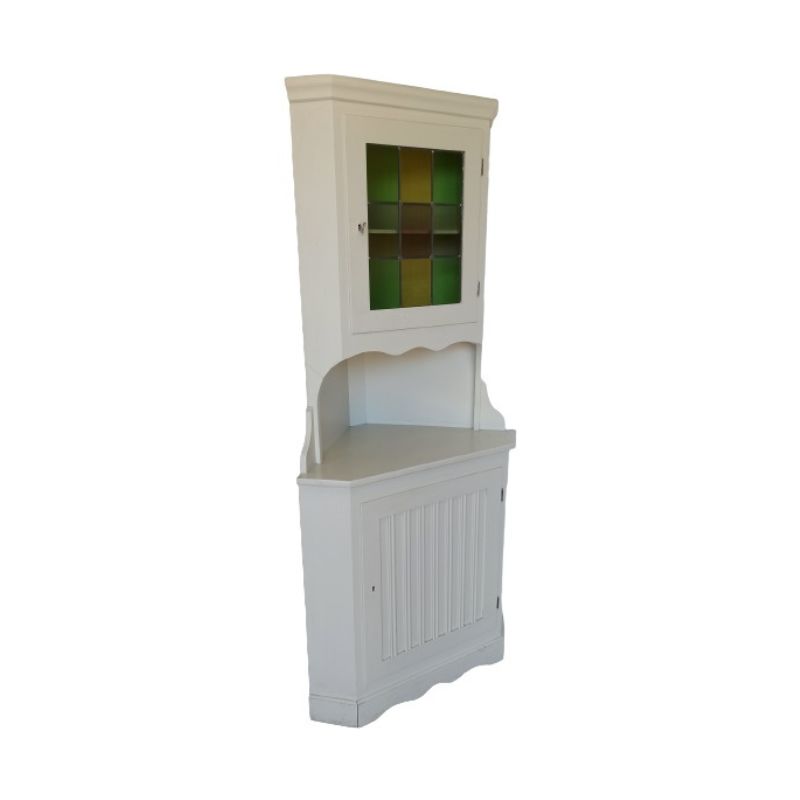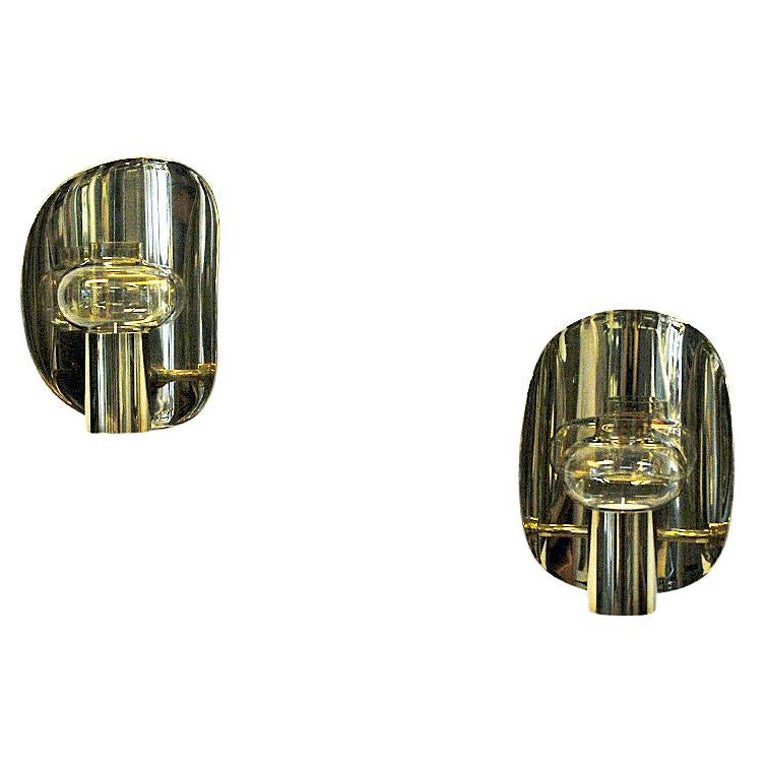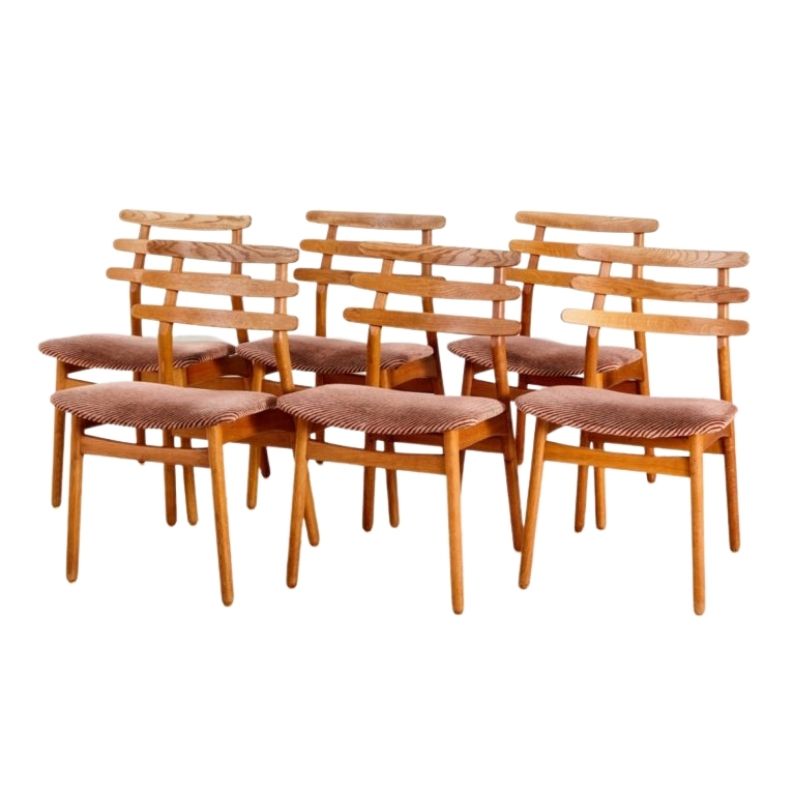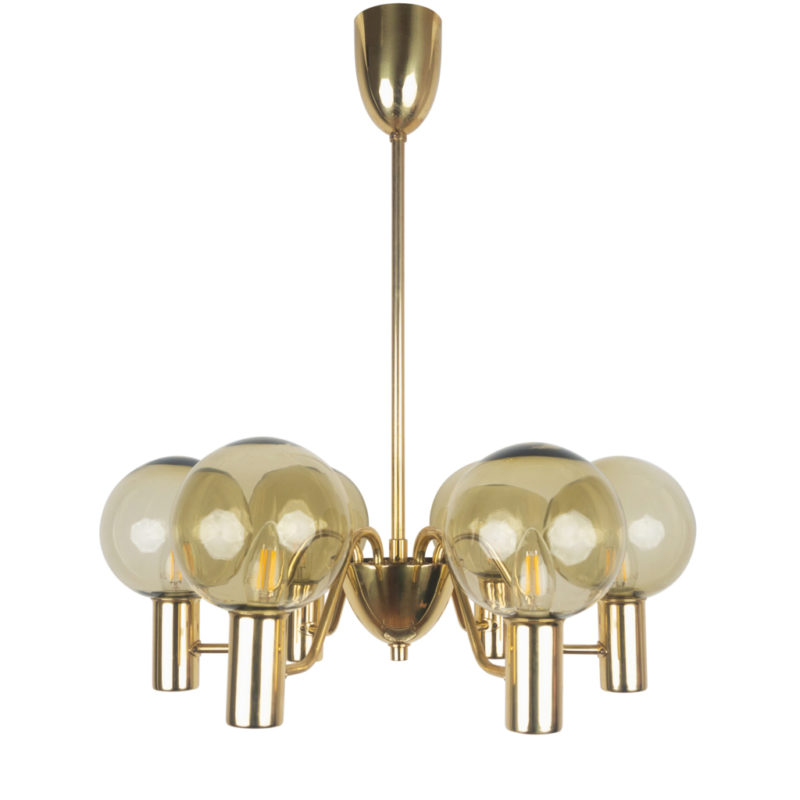from a afar and start trying to understand how he did what he did. Oh, Koen? Or anyone. Lend my eyes a hand. First, to master the obvious as only a layman can do: Wegner had to have one of the most intense streaks of genius in chair design ever, I suppose. I'm using genius here in the following sense. He seemed to create forms that were so tightly and rightly strung/composed that one could not whittle away one splinter anywhere without completely unbalancing it visually. This guy had a set of surgical lasers for eyes before lasers were even invented. He designed chairs the way I think everything should be designed. He seemed to start with a human being in some desired position, then looked at touch points with context, then orchestrated a rational music of lines, forms and massing rising from these contact points with context to meet at touch points on the human being in the desired position. I know he's said to be influenced by Picasso visually (and that seems obvious even to a layman in the Ox Chair), but I would liken his construction much more to the evolving structure of certain symphonic music. We know where the piece has to start, because he tells us with the contact points to context. And we know where the piece has to evolve to because we know what his aspiration is (to support a human in a particular position). But its absolutely, breathtakingly, wonderfully impossible to anticipate how the music builds to where we know it has to go. And yet after we see it the first time, we can't imagine how it could have gone any other way, again rather like a wonderful musical piece. How the devil did he do this? Some one explain his Ox chair to me first. How did he get away with that head rest? I mean its totally outrageous and yet totally right. It almost seems he was making a little joke about Eames chairs or men's easy chairs in general, but whether or not there was a joke, its still a stunningly RIGHT chair. Is it because he was inverting the massing of the chair as a unifying visual theme at every level of the composition; i.e., outrageously skinny legs and frame connecting up to this relatively massive, stuffed chair and then topped it with a head rest that was as much more massive than the stuffed chair as the chair was more massive than the legs? The Ox Chair seems the least typical of his work in many ways, but it nevertheless shares this remarkable ability to move from the contact points with context to the touch points with the human body in ways that one can't anticipate and then seem inevitably rational after the fact. An amazing designer. Can any one break down the aesthetics that make the Ox chair work visually? Am I overstating this guy's genius? I don't think so. I know he's probably been done to death by design critics, but I'd like to hear some designers comments.
I'm not much into explaining...
I'm not much into explaining furniture. But you're certainly not overstating Wegner's genius. He's truly is one of a kind and when you obtain such a status, then there surely must be something genius about you. I've seen the final piece Wegner made as a young man when he ended his training as a master cabinetmaker. It's a large cabinet and it must be without a doubt the most impressive piece of design/craftmanship I've ever come across and probably ever will. Peder Moos, go home. It stands at the Kunstindustrimuseum here in Cph.
The Oxchair just works. My father owns one with matching ottoman and it's just pleasing to the eye from every possible angle. And the comfort is superb. It's of the few chairs I would describe as being truly masculine ... a real man's chair. Yeeeaaah!
I hope this question
will attract someone more qualified than myself. When confronted with difficult questions in my professional life I have often asked myself: "how would.....solv this?" The dots stand for the people I consider great exemples from the past: Henri Dreyfuss, Castiglioni, Kjaerholm,etc. or the present, Renzo Piano, David Mellor, Konstantin Grcic. In form analysis it would be my former teacher the Belgian art historian Jacques Watelet. Untill a few weeks ago, I could have asked him, but he passed away at the respectable age of 90. So let me try to remember how he looked at it when it came up for discussion when I was one of his students in 1960.
There are of course two ways to look at it. One might is the possible inspiration and how that idea was developed the other is simply the end result and why it seems to work so well.
I have not seen real evidence of the link to Picasso's work, other than that the end result, especially seen from the back looks very much like a charging bull. The extended back legs, clearly spread for stability surmounted by what could be seen as a bulls head. The arm rests form a substantial body and the frontlegs of the chair (back legs of the bull) have a typical bovine angle.I am always suspicious of that kind of "inspiration" because in the course of sketching you always see all kind of visual connotations and we human beings could not look at the stars or the moon without seing animals or in the last case a face. I have never seen any scientific evidence that starts were placed in that particular pattern for that reason so I suppose that it is part of human nature to make these patterns and part of human joy to discouver them...especially resting on your back on a warm summer afternoon and looking at the small clouds that try to put a scale to the vastness of the blue sky...
In the case of Hans J. Wegner (my admiration for this Danish giant was the reason why I was happy to write his biography for the DA index) that kind of inspiration is very likely because there are so many other exemples of it. The 9..or more? "chinese" chairs were clearly inspired by traditional chinese furniture, the "peacock" chair was an inspired extention of a Windsor chair and his foulding chair of 1949(nr 512) was inspired by an african folding chair, just to name a few. Within Wegners own work there are also older indications of this wide head rest or at least of a similar build up of shapes. Just by the name of them. it is unlikely that the "Cow horn chair" and the "Bull horn chair" had nothing to do with this configuration but there are other indication. There is an easy chair prototype from 1953 that is a basic variation of the six years earlier designed "Peacock" chair with the head rest couvered with leather over the total width and that shows already how well this exagerated shape works well.
cont.
Those who, by experience, know how sketching works, also know that your own hand sometimes, just by missing a line, or by correcting another, shows a possibility or an image that goes beyond the concious direction of your imagination. In discouvering that "unwanted" image one can be inspired to do unusual things or create vartiations on themes that have been explored previously...if I knew how to put pictures in my text, I would copy a page or two of my own sketchbooks....
All of this does not mean anything when it comes to the successfull outcome. In other words, being inspired by Picasso's obsession with bull fighting does not lead to good design and neither does the inspiration of chinese or old english chairs...so. lets start by the end result.
As with many products, the monolithic endresult is always attractive. Monolithic in this case certainly relates to the "bull" or "Ox" image that we se as a "whole" and not as a build up of many parts. The strong backward angle certainly gives it an inviting look, but the key here is a rather interesting visual effect. between the arm rests and the head rest. Please bear with me in trying to explabne this. In order to discouver what pleases your eye you should look both from the arm rests up to the head rest and vise versa. Basically in the first case it makes a mouvement from the enclosed shape formed by the arm rests to a wide open inviting gesture of the head rest. If you do it the reversed way, from the head rest down to the arm rests it is almost an inviting gesture of "please sit down here". Just consider the two elements (head rest and arm rest) as two frames in an animated film. Again one needs a good visual picture of the whole chair to see it clearly. Seen from the back it is obvious that the head rest is a repetition of the combined arm rests, in fact the seem between the head rest both in front, but even more so in the back shows clearly that it is a repetion of the armrest with an identical drop shaped end, accentuated by a seem around a separate piece and flaring out in a flatter shape that in the armrest is linked to the back and in the head rest returns to the drop shape on the other side. In a certain way it is a chair that "opens" its arms to wellcome you. The light metal frame makes that even more obvious. Maybe I should add yet another analogy. Just imagine the head of a teddy bear in the middle and on top of the head rest...This is a chair that says: "please sit in my lap..."
It's success is of course related to the fact that it is so well proportioned (40'x40'x36' is a visually corrected cube, but that is another story) and it delivers on it's promise to be very very comfortable!....sorry I have already taken too much of your time...and I think that Hans J. Wegner, even at his respectable age would have a good laugh if he would read this...
Thank you Martin and Koen...
You have given me some insights here and not dulled the wonder a bit.
Now let me ask one more question of you both, or of anyone else who might wish to answer. Could you conceive of an Eames easy chair and ottoman and the OX chair and ottoman coexisting pleasingly in the same room?
I'm asking this question, not to decorate my house, but rather to explore the nature of, how shall I say it, definitive designs. Do they so rigorously command the eye and define the formal expectations in the space around them that they cannot coexist harmoniously with another definitive expression of the same artifact type? Though I suspect it is the case, I hope not for it vaguely implies two extraordinary, definitive persons cannot coexist well...and I like to think they can.
I pick the Eames and Wegner easy chairs as but one example of an issue I'm generally curious about: mutual exclusivity vs. counterpoint in equilibrium. Certain different interpretations of like things don't go together, regardless of how wonderful they each are on their own, because their forms, colors, textures, etc. clash in an ugly, tasteless way. But I think some other different intepretations of like things can create a fascinating counterpoint and pleasing tension.
Anyone care to comment on whether or not and why an Eames easy chair and a Wegner OX chair could coexist in a room pleasingly? They would seem to create a kind of tension and counterpoint of expression that would be bad, but I can't say exactly why. Also, something in me whispers that some interior designer might surprise me and find a way to make them contribute to a pleasing and startling interior--and wouldn't that be wonderful to have two such marvelous chairs to share a conversation with a friend in. My friends are not identical to me. I always feel a little peculiar when I sit in a conversation in which we are in identical chairs. It seems a disingenuous contrivance that undermines the give and take. At the same time, we share much in common or we would not be sitting there, so the chairs ought not clash. I have the same feelings when all these different persons are sitting around a conference table on exactly identical chairs. We are not identical and so the environment seems an inauthentic contrivance.
Perhaps thinking about these two at once very different and at once similar chairs in one room gets at some kind of yearning in me for different unique human beings to get along. Regardless, I can't help asking you folks about these two remarkable chairs together.
Hmmm. Well, how big is the...
Hmmm. Well, how big is the room?
I don't think I would place them very close to each other. They both demand their space and one should respect that, otherwise it will harm the perhaps intended impression of both the chair and the surroundings.
The Oxchair has a powerful yet simple appearance, but the Eames chair is much more detailed in its construction and has many more places that will attract and capture your eyes' attention. It's also a bit higher, I think, however I'm sure that the Oxchair's horns and the seat's width will counterweight this succesfuly.
Hmmm. It's not just about the shape of each chair. Usually the Eames chair is in black leather but I wouldn't personally choose to also have the Oxchair in black leather. It just wouldn't be fair to have both chairs in the same room and in the same colour. They're so different and beside the fact that they're both chairs, there shouldn't be an obvious opportunity to compare them to each other, fx. by keeping them both in the same colour.
If they were to be placed in my living room, I would have the Eames chair in white/black cowhide and the Oxchair in pure purple fabric. I think the Oxchair is better suited for bright colours. In the old days they made the "fabric-tubes" around the drop-shaped plated at the end of the horns and armrests in brown leather and then the rest of the chair in fabric. I've always thought that this was such a nice detail, a shame Erik Joergensen hasn't decided to include this org. detail in the current production.
All in all, yeah I think they can co-exist in the same room IF you pay special attention to the choice of colour and give them space to roam.
BTW, I found a picture of another Wegner chair with a large headrest: 
Damn, I've searched and searc...
Damn, I've searched and searched the net for a picture but with no luck. You see, originally there was also produced a sort of sterilized Oxchair with no horns in very limited numbers, only around 30 chairs in all. I have it in a few auction catalougs and it looks really weird, almost like someone amputated the horns of the poor chair.
Try as I might
I can't imagine the two chairs in one room..
I love them both, own neither..but given the choice would go for the Wegner.
Maybe its a global thing?
Some design doesn't travel well in my opinion.
I look at some American design, and find it really alien..
It just me, or do you guys in the US find some European 20C design hard to fathom ?
EU design
In my opinion they can both be alien, but American design that has made it into the canon is more consistently so. I like Wegner's chair and if I am recollecting correctly, it was quickly taken out of production for being too good and too expensive (the two reasons a person won't buy it). American design seems to process design in a way that eliminates both possibilities. Marketing and demographic analysis is part of the design process here. EU design, and certainly this Wegner chairs seems to want to disrupt that, which is more respectable. I believe Wegner and his people are completing an exhaustive survey of his work - would anyone know the status of that tome?
In general, I can see combinations of
masterpieces, but in this case I see two problems, none of which has to do with the analogy of inviting two famous guests to a party...
The first one is that it is always difficult to combine two pieces with exactly the same function, that goes for place settings, pendants, trolleys, book shelfs, etc. no matter how good the design, no matter how masterfully crafted. It will always feel strange. Whereas combinations of well designed products with different functions from different designers often do well.
The second reason is the nature of the two products. If we put the function and comfort considerations aside, the Eames chair is the result of a technical exploration ito the use of formed plywood and the industrial application of it. Let me just point out one detail. In the juxtaposition of the "sit-shell" and the "back shell" the negative form (we know now what that is) or the space left between the shells is not very well defined. the edges are neither parallel, nor do they create an interesting shape. The reason is simple. Eames simply repeated the both shapes but cut the back rest soemwhat shorter. So the negative space is simply a repetition of the same shape but under an angle (the angle between the backrest and the seat. This is a deliberate "industrial" choice. The Eames chair is full of them. The Ox-chair is the result of a form study and has written "Handmade-by-skilled-crafts-people" written all over it. So in spite of both being excellent designs the come from different worlds or at least from a very different approach. Unless your interior is a museum (and sometimes some parts of it are, like Olive's teapot collection) you most likely put your interior together with products that witness of the same approach, which is the one consistent with your own preferences. Unless the "collector reflex" prevails, I do not think that putting these two masterpieces together is a good idea.
WOW! University of Design Addict
This is all wonderful. Its hard to type when I'm jumping up and down. The teacher to student ratio at this school is the best in history.
Martin, I could see that black and white cow hide Eames with the purple OX apart in a big room instantly. Thanks for stretching a little for me. I know you're not saying it would be great to do. But you helped me see how color and pattern might be used to interconnect such different design icons.
Koen, it never occurred to me to segment interior design along the process axes of industrial study vs. form study; though of course now that you mention it, it seems painfully obvious. Are there still other process axes that you use to characterize design generally?
I know, I know, I'm going to have to start paying tuition if I keep asking these questions.
Hi Don...
The "visuals" that coem with your expressions of appreciation makes it difficult not to answer every question with at least as much insight as your level of entusiasm. This being said, I think that it is more appropriate to link the insight to a particular exemple, like in this case the Ox-chair...this is one of those pedagogical things I care about...so I hope to have an opportunity to share some other "axes" with you.
I would like to sidestep this "Wegner" thread to draw attention to the fact that behind these wonderful products there are skilled, passionate people that dedicate themselves to producing these often difficult lines and curves to perfection. One of them is Lasse Christensen, a 21 years old cabinetmaker with PP Möbler in Alleröd (sorry for the swedish "ö", I can not find the danish one on my keybord) Alleröd is of course the birthplace of Hans J. Wegner and PP Möbler the producer of most of his furniture. After winning the Danish championship in cabinet making, Lasse Christensen won the Nordic competition in Lilleström Norway on the 25th oif october by making a sewing table in the allowed time of 18 hrs. He is off to Shizuoka, Japan for the world championships late 2007. I know, this has not much to do with design ...but what do you want...this is my little world.
Off line someone got slightly uppset with me because I "planted" the image of a headless teddy bear in his mind. "I can not look at the Ox-chair anymore without seeing that.....image" I am sorry for that, but considering that Hans J.Wegner had already made a "Pappa Bear" chair, the image was too obvious. He has always taken humor very seriously and is a good exemple of the careful balance between the seriousness of a product and it's capability to make us smile...
If you need any help, please contact us at – info@designaddict.com









